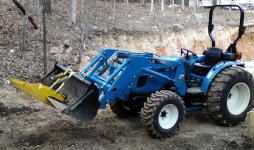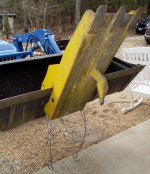Gary Fowler
Super Star Member
- Joined
- Jun 23, 2008
- Messages
- 11,998
- Location
- Bismarck Arkansas
- Tractor
- 2009 Kubota RTV 900, 2009 Kubota B26 TLB & 2010 model LS P7010
I have also dug out rocks that size and larger with my FEL(no grapple) on my LS P7010 but it is not easy on the FEL and takes a much larger hole than the rock to be able to get under them. Around here the big mother rock is usually surrounded by a bunch of smaller babies so it is really hard to dig them out with the FEL. Now I use my Kubota B26 TLB with hydraulic thumb to dig up any rocks I find that I cant pry out with my "pickle fork" that I carry around in my RTV. I have removed all of the big ones that are showing so now it is just the new crop that shows up every spring. I am thankful that I have the TLB as it was a bit hard on my LS trying to dig them out with just the FEL. The last really big one I got out was so large that I couldn't lift it with the Kubota backhoe. I managed to get the rock rolled around to the edge of the pit, put the LS bucket under the edge of the rock and used the backhoe to slide it in the LS FEL bucket. Sometimes it is great to have two tractors, especially if you have one stuck in the mud or something.I have taken out more than my fair share of road rocks, all sizes, with my tractor. If your road freezes solid in winter and then you have a muddy season when the frost starts to come out; that is the absolute best time to get the rocks out. It seems they almost float out in the mud and water that fills the holes. Once the road drys out it is much harder to free them.
Also in addition to your tractor you would be surprised at what a heavy 5 foot bar can do to help you.
Up to this size is easy. Bigger ones are more work. I took this when I was testing my new grapple. That is why the road is dry.
View attachment 372304
P.S. I did find one that the point was under a pine tree that I had knocked down. I started digging around it and after about 8 feet in length and 5 feet in depth and still no end in site, I filled in the hole with the dirt minus the smaller rocks that were around the big one. I used the smaller stuff for my creek crossing "bridge".


